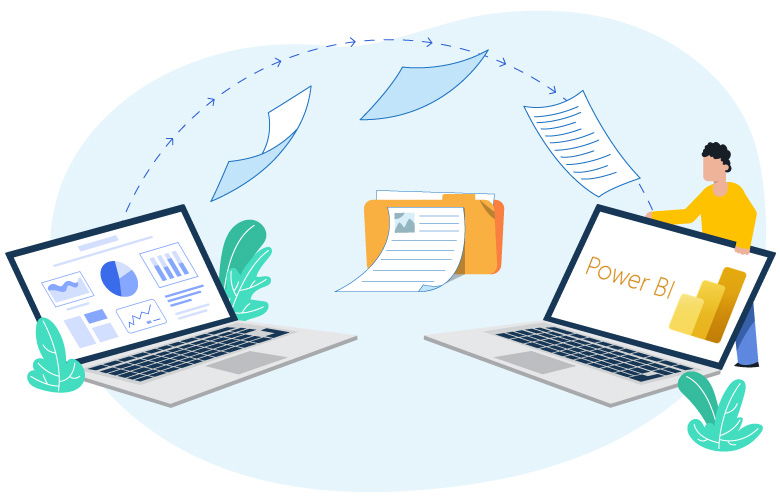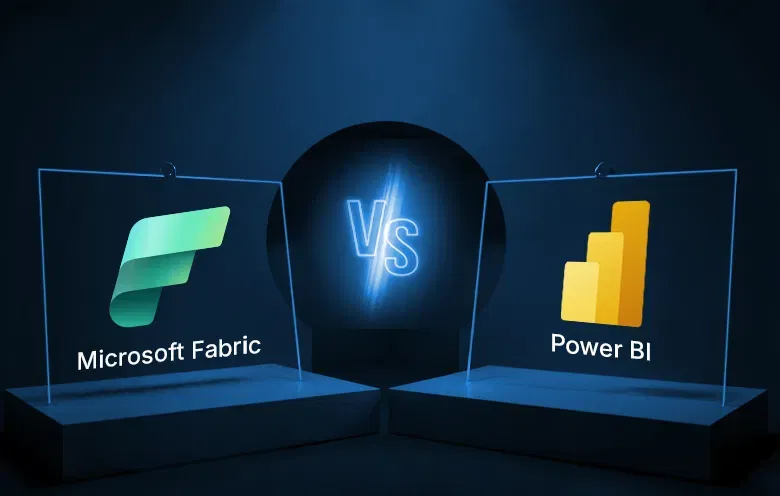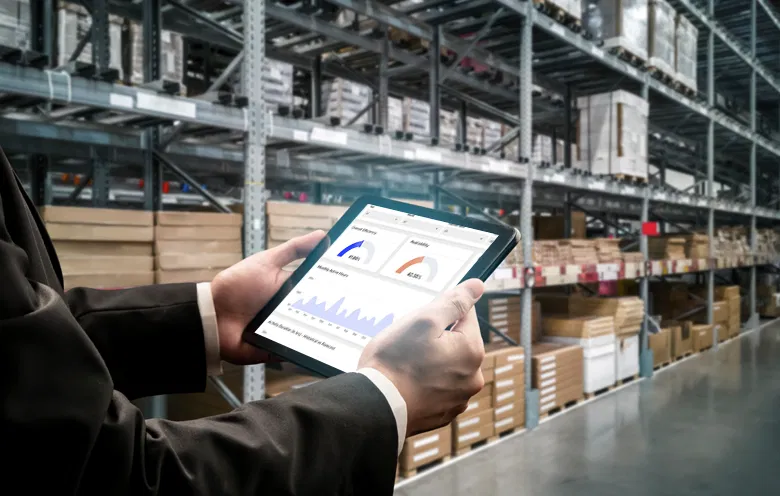The business landscape is like a fabric—if the cloth is the underlying structure that holds everything together, then the color is what brings it to life, making it vivid and engaging. Microsoft Fabric serves as that sturdy cloth, weaving data from various sources to create a resilient foundation. Power BI brings color, transforming structured data into compelling visuals and actionable insights. Together, they form a cohesive tapestry that empowers businesses to see their operations in full detail, from the foundational layers to the insights that drive strategic decisions.
“Where there is data smoke, there is business fire” – Thomas C Redman, the ‘Data Doc’, founder and President of Data Quality Solutions
Microsoft Fabric and Power BI both have their unique features, strengths, and a few trade-offs. When to choose these Microsoft tools depends on your business requirements. Before making a perfect choice, you may have asked yourself questions like:
- Do I need Fabric for Power BI?
- What is the difference between Power BI and Fabric?
- Which tool is better than Power BI?
- Is Microsoft Fabric same as of Power BI?
These questions reflect thoughtful considerations that help users make informed, data-driven choices. In this blog, we’ll understand what Power BI and Microsoft Fabric are, their core differences, use cases, and the business impact on ROI.
Introduction to Microsoft Fabric and Power BI
Microsoft Fabric and Power BI each provide unique value in data management but serve distinct roles within the data ecosystem. Below is a closer examination of their individual capabilities.
What is Microsoft Fabric, and why does it matter for organizations?
Microsoft Fabric is a unified analytics platform that brings data professionals and business users together in one environment to collaborate efficiently on data initiatives. It is a centralized platform that manages enterprise-level data through integration, storage, and advanced processing across multiple sources. It excels in data management and enables seamless support for analytics, reporting, and machine learning.
Microsoft Fabric services provide a seamless way to integrate, store, and process enterprise-level data within the Microsoft ecosystem. These services enhance the platform’s capabilities by ensuring that businesses can leverage powerful analytics and reporting tools to unlock deeper insights.
What sets Microsoft Fabric apart?
-
Unified approach:
Microsoft Fabric provides a single platform for data movement, data engineering, data science, and real-time analytics, reducing complexity and streamlining workflows.
-
Built-in AI capabilities:
Integrating Azure AI with Microsoft Fabric enhances data processing, enables predictive analytics, and automates tasks.
-
Lake-centric architecture:
OneLake storage enables data to be stored in its original format without needing to be moved or duplicated, enhancing efficiency and reducing costs.
When to use Microsoft Fabric?
Businesses should choose Microsoft Fabric when they need to:
- Work with large-scale, enterprise-level data and AI workloads
- Build end-to-end data pipelines across multiple business functions
- Construct a modern and lake-centric architecture for complex data management
- Design a unified platform for data integration, engineering, and analytics
What is Power BI, and why does it matter for organizations?
Power BI is an interactive data visualization and reporting platform developed by Microsoft. It combines various services, apps, and connectors to pull data from different sources and turn it into visually rich reports. Power BI analyzes massive amounts of data and translates it into easy-to-use reports and dashboards. It is a dynamic yet intuitive resource that creates meaningful and shareable insights without needing advanced technical skills.
With features like data modeling, AI-powered insights, and user-friendly visuals, Power BI empowers analysts and decision-makers to make informed choices out of quickly interpreted data. Power BI services offer tailored guidance and implementation, helping businesses optimize reporting, decision-making, and insights with Power BI’s full capabilities.
What sets Power BI apart?
-
Real-time insights:
Power BI supports real-time data streaming and live dashboards for quick decision-making.
-
Enterprise-grade capabilities:
It offers robust governance, data security, and scalability to meet enterprise-level demands.
-
Custom visualizations:
Users can create custom visualizations using R programming and Python, extending beyond the standard chart types.
When to use Power BI?
Businesses should choose Power BI when they need to:
- Create interactive dashboards and visual reports for business users
- Focus primarily on data visualization and self-service analytics
- Integrate with Microsoft tools for accessible reporting and sharing
- Transform data, ensuring data is clean and ready for analysis
- Quick insights with minimal data engineering setup
Best practices for seamless Power BI migration in our quick guide.
Discover how Power BI migration empowers faster decision making with real-time data, stunning visualizations, and seamless integration.

Power BI vs Microsoft Fabric: Key differences
To illustrate the distinctions between Power BI vs Fabric, here’s a side-by-side comparison that outlines their primary purposes, core features, target users, and integration capabilities:
| Feature | Power BI | Microsoft Fabric |
|---|---|---|
| Primary Purpose | Data visualization and reporting | Data engineering, integration, and storage |
| Key features | Interactive dashboards, data modeling, AI insights | Data storage, integration, and scalable processing |
| Target users | Business analysts, decision-makers | Data engineers, IT teams |
| Integration | Works seamlessly with Excel, Teams, SharePoint, and Fabric | Integrates with Azure, Power BI, and other Microsoft services |
Power BI and Fabric serve different stages in the data lifecycle. Fabric manages the backend processes for data structuring and integration, while Power BI is the final layer, transforming processed data into actionable business insights.
Organizations experienced a 27% faster time to insights when utilizing these tools, streamlining the process of obtaining actionable data and enhancing decision-making capabilities – Forrester Study
Ideal use cases
Understanding the nuances of Power BI vs Microsoft Fabric helps organizations leverage the strengths of both tools effectively. Both Power BI and Fabric add significant value but address different needs:
Power BI:
Businesses continuously strive to make sese of data they possess. Power BI implementation helps transform complex datasets into actionable insights driving smarter decision-making. Businesses strongly in need of data visualization with frequent reporting requirements find a highly resourceful tool in Power BI. It simplifies the creation of dynamic and insightful dashboards.
Fabric:
Tailored for large-scale data management and processing, Fabric is essential for businesses needing robust solutions for data integration and storage, especially where complex data ecosystems are involved.
Using both together:
In enterprise-wide analytics, Power BI and Fabric complement each other seamlessly. Fabric handles the intricate aspects of data integration and storage, while Power BI transforms this well-organized data into valuable insights that fuel strategic planning.
Business impact and ROI
When evaluating the tools in the context of Power BI vs Microsoft Fabric, both can drive transformational change, delivering a high return on investment. Fabric’s centralized structure streamlines data access and integration. It greatly reduces time spent on data preparation. Power BI enhances accessibility and enables non-technical users to quickly uncover insights and drive faster, data-informed decisions.
By reducing manual processes and enabling automation, both tools help organizations operate more efficiently, fostering a data-centered approach that enhances decision-making. Together, these tools strengthen business efficiency, maximizing productivity, and enabling long-term gains.
Final insights
In summary, when considering the landscape of data tools, the choice between Power BI vs Fabric becomes crucial for optimizing data strategy. Fabric provides a resilient foundation for managing complex data workflows, while Power BI brings that data to life, turning raw data into insights for strategic decisions. Distinct yet complementary, they embody Microsoft’s vision for integrated data solutions.
To fully harness the power of these tools, partnering with experts can make all the difference. Softweb Solutions can help you implement Microsoft Fabric and Power BI solutions tailored to your business’s unique needs, ensuring that your data works as hard as you do. Contact us to see how our expertise can elevate your data strategy.


